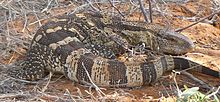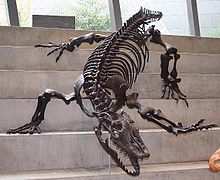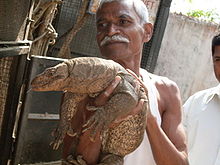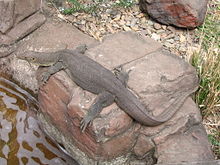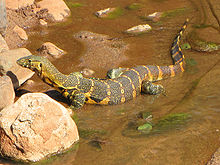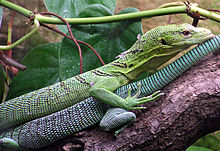- Monitor lizard
-
Monitor Varanus albigularis Scientific classification Kingdom: Animalia Phylum: Chordata Class: Reptilia Order: Squamata Suborder: Scleroglossa Infraorder: Anguimorpha Superfamily: Varanoidea Family: Varanidae Genus: Varanus
Merrem, 1820Species Over 70, see text. Monitor lizards are usually large reptiles, although some can be as small as 20 centimetres (7.9 in) in length. They have long necks, powerful tails and claws, and well-developed limbs. Most species are terrestrial, but arboreal and semiaquatic monitors are also known. Almost all monitor lizards are carnivorous, although Varanus bitatawa, Varanus mabitang and Varanus olivaceus are also known to eat fruit.[1][2] They are oviparous, laying from seven to 37 eggs, which they often cover with soil or protect in a hollow tree stump.[3]
Contents
Distribution
The various species of Varanus cover a vast area, occurring through Africa, the Asian subcontinent from India and Sri Lanka to China, down Southeast Asia to Indonesia, the Philippines, New Guinea, Australia and islands of the Indian Ocean, and South China Sea. There is also a large concentration of monitor lizards in Tioman Island in the Malaysian state of Pahang.
Evolution
Monitor lizards differ greatly from other lizards in several ways, possessing a relatively high metabolic rate for reptiles, and several sensory adaptations that benefit the hunting of live prey. Recent research indicates the varanid lizards may have some venom.[4] This discovery of venom in monitor lizards, as well as in agamid lizards, led to the Toxicofera hypothesis: that all venomous lizards and snakes share a common venomous ancestor.[5]
During the late Cretaceous era, monitor lizards or their close relatives are believed to have evolved into amphibious and then fully marine forms, the mosasaurs, which reached lengths of up to 17 m.
Snakes are believed to be more closely related to monitor lizards than any other type of extant reptile, but it has been proposed that snakes are sister group of the clade of iguanians and anguimorphs.[5]
During the Pleistocene epoch, giant monitor lizards lived in Southeast Asia and Australasia, the best known fossil being Varanus priscus (formerly known as Megalania prisca). This species is an iconic member of the Pleistocene megafauna of Australia.
Some monitor lizards, including the Komodo dragon, are capable of parthenogenesis.[6]
Etymology
The generic name Varanus is derived from the Arabic word waral ورل, (alternative spelling waran). The name comes from a common Semitic root ouran, waran, or waral meaning "lizard".[7] The occasional habit of varanids to stand on their two hind legs and to appear to "monitor" their surroundings has been suggested to have led to this name, as it was Latinized into Varanus. Its common name is derived from the Latin word monere meaning "to warn".[7]
In Tamil and Malayalam, monitor lizards are known as udumbu, ghorpad घोरपड in Marathi, uda in Kannada, in Sinhalese as kabaragoya, and in Telugu as Udumu. Due to confusion with the large New World lizards of the family Iguanidae, the lizards became known as "goannas" in Australia. Similarly, in South Africa they are referred to as leguaan, from the Dutch for iguana. The generic name inspired the name of the Japanese movie monster Varan.
Intelligence
Varanid lizards are very intelligent, and some species can even count.[8] Careful studies feeding V. albigularis at the San Diego Zoo varying numbers of snails showed that they can distinguish numbers up to six.[8][9] V. niloticus lizards have been observed to cooperate when foraging.[8] One varanid lures the female crocodile away from her nest, while the other opens the nest to feed on the eggs.[8] The decoy then returns to also feed on the eggs.[8][9] Komodo dragons, V. komodoensis, at the Smithsonian National Zoological Park in Washington, D.C., recognize their keepers and seem to have distinct personalities.[9]
In captivity
Monitor lizards have become a staple in the reptile pet trade. The most commonly kept monitors are the savannah monitor and Acklin's monitor, due to their relatively small size, low cost, and relatively calm dispositions.[7] Nile monitors, white throated monitors, water monitors, mangrove monitors, emerald tree monitors, black tree monitors, acanthurus monitors, quince monitors, crocodile monitors and komodo dragons have been kept in captivity.[7] Like all reptiles kept as pets, monitors need hiding places and an appropriate substrate.[7] Monitors also need a large water dish in which they can soak their entire bodies.[7] In the wild, monitors will eat anything they can overpower, but crickets, superworms, and the occasional rodent make up most of the captive monitors' diet. Boiled eggs, silkworms, earthworms, and feeder fish can also be fed to them.[7] Paleontologist and Biology Professor at Temple University, Michael Balsai has observed V. prasinus eating fruit in captivity as has herpetologist and author, Robert G. Sprackland.[7][10]
Culinary uses
Monitor lizards are eaten in parts of southern India and Malaysia, where their meat is considered an aphrodisiac.[11][12]
Protected status
All but five species of monitor lizard are classified by CITES (the Convention on International Trade in Endangered Species of Wild Fauna and Flora) under Appendix II, which is loosely defined as species that are not necessarily threatened with extinction, but may become so unless trade in such species is subject to strict regulation in order to avoid utilization incompatible with the survival of the species in the wild. The remaining five species - V. bengalensis, V. flavescens, V. griseus, V. komodoensis, and V. nebulosus - are classified under CITES Appendix I, which means they are species that are threatened with extinction.[13]
In the Indian state of Tamil Nadu and all other parts of South India, catching or killing of monitor lizards is banned under Protected Species Act.
Classification
Genus Varanus
- V. acanthurus, Ridge-tailed Monitor
- V. a. acanthurus, Spiny-tailed Monitor or Spiny-tailed Goanna
- V. a. brachyurus, Common Ridge-tailed Monitor
- V. a. insulanicus, Island Ridge-tailed Monitor
- V. albigularis, Rock Monitor
- V. a. albigularis, White-throated Monitor
- V. a. angolensis, Angola White-throated Monitor
- V. a. ionidesi, Black-throated Monitor
- V. auffenbergi, Peacock Monitor
- V. baritji, Northern Ridge-tailed Goanna
- V. beccarii, Black Tree Monitor
- V. bengalensis, Bengal Monitor [Endangered]
- V. b. bengalensis, Bengal Monitor [Endangered]
- V. b. nebulosus, Clouded Monitor [Endangered]
- V. bitatawa, Northern Sierra Madre Forest Monitor Lizard, Bitatawa
- V. boehmei, Golden-spotted Tree Monitor
- V. bogerti, Bogert's Tree Monitor
- V. brevicauda, Short-tailed Monitor
- V. bushi, Pilbara Goanna
- V. caerulivirens, Turquoise Monitor
- V. caudolineatus, Stripe-tailed Goanna
- V. cerambonensis, Ceram mangrove Monitor
- V. cumingi, Cuming's Water Monitor
- V. doreanus, Blue-tailed Monitor
- V. dumerilii, Dumeril's Monitor
- V. eremius, Desert Pygmy Goanna
- V. exanthematicus, Savannah Monitor
- V. finschi, Finsch's Monitor
- V. flavescens, Yellow Monitor [Endangered]
- V. giganteus, Perentie
- V. gilleni, Pygmy Mulga Goanna
- V. glauerti, Kimberley Rock Monitor
- V. glebopalma, Black-palmed Rock Monitor
- V. gouldii, Sand Goanna or Gould's Goanna
- V. g. gouldi, Gould's Goanna
- V. g. flavirufus, Desert Sand Monitor
- V. griseus, Desert Monitor [Endangered]
- V. g. griseus, Western Desert Monitor [Endangered]
- V. g. caspius, Eastern Desert Monitor [Endangered]
- V. g. koniecznyi, Thar Desert monitor [Endangered]
- V. indicus, Mangrove Monitor
- V. jobiensis, Peach-throat Monitor
- V. juxtindicus, Rennell Island Monitor
- V. keithhornei, Canopy Goanna
- V. kingorum, King's Goanna
- V. komodoensis, Komodo Dragon [Endangered]
- V. kordensis, Kordo Tree Monitor
- V. lirungensis, Lirung Monitor
- V. mabitang, Panay Monitor
- V. macraei, Blue-spotted Tree Monitor
- V. marmoratus, Marbled Water Monitor
- V. melinus, Quince Monitor[14]
- V. mertensi, Mertens' Water Monitor
- V. mitchelli, Mitchell's Water Monitor
- V. nebulosus, Clouded Monitor [Endangered]
- V. niloticus, Nile Monitor
- V. nuchalis, Spiny-necked Water Monitor
- V. obor, Sago Monitor
- V. olivaceus, Gray's Monitor
- V. ornatus, Ornate Monitor
- V. palawanensis
- V. panoptes
- V. p. panoptes, Argus Monitor
- V. p. horni, Horn's Monitor
- V. p. rubidus, Yellow-spotted Monitor
- V. pilbarensis, Pilbara Rock Monitor
- V. prasinus, Emerald Tree Monitor
- V. primordius, Blunt-spined Goanna
- †V. priscus, Megalania
- V. rainerguentheri
- Varanus rasmusseni
- V. reisingeri, Reisinger's Tree Monitor
- V. rosenbergi, Rosenberg's Goanna or Heath Monitor
- V. rudicollis, Black Roughneck Monitor
- V. salvadorii, Crocodile Monitor
- V. salvator, Water Monitor
- V. s. salvator, Asian Water Monitor
- V. s. andamanensis, Andaman Islands Water Monitor
- V. s. bivittatus, Two-striped Water Monitor
- V. s. komaini, Black Water Monitor
- V. s. macromaculatus, Southeast Asian Water Monitor
- V. scalaris, Spotted Tree Goanna
- V. semiremex, Mangrove Pygmy Goanna
- V. spenceri, Spencer's Goanna
- V. spinulosus, St. Isabel Mangrove Monitor
- V. storri, Storr's Goanna
- V. s. storri, Eastern Storr's Goanna
- V. s. ocreatus, Western Storr's Monitor
- V. telenesetes, Rossel Island Tree Monitor
- V. timorensis, Timor Tree Monitor
- V. togianus, Togian Water Monitor
- V. tristis, Black-headed Monitor
- V. t. orientalis, Freckled Monitor
- V. varius, Lace Monitor
- V. yemenensis, Yemen Monitor
- V. yuwonoi, Tri-colored Monitor
- V. zugorum, Zug's Monitor
References
- ^ Greene, Harry W. (1986). Diet and Arboreality in the Emerald Monitor, Varanus Prasinus, With Comments on the Study of Adaptation. Field Museum of Natural History. ISBN 9998057760.
- ^ Zipcodezoo.com
- ^ Bauer, Aaron M. (1998). Cogger, H.G. & Zweifel, R.G.. ed. Encyclopedia of Reptiles and Amphibians. San Diego: Academic Press. pp. 157–159. ISBN 0-12-178560-2.
- ^ Fry, B.G.; Wroe, S; Teeuwisse, W; van Osch, JP; Moreno, K; Ingle, J; McHenry, C; Ferrara, T; Clausen, P; Scheib, H; Winter, KL; Greisman, L; Roelants, K; van der Weerd, L; Clemente, CJ; Giannakis, E; Hodgson, WC; Luz, S; Martelli, P; Krishnasamy, K; Kochva, E; Kwok, HF; Scanlon, D; Karas, J; Citron, DM; Goldstein, EJC; Mcnaughtan, JE; Norman JA. (June 2009). "A central role for venom in predation by Varanus komodoensis (Komodo dragon) and the extinct giant Varanus (Megalania) priscus.". PNAS 106 (22): 8969–8974. doi:10.1073/pnas.0810883106. PMC 2690028. PMID 19451641. http://www.pnas.org/cgi/doi/10.1073/pnas.0810883106.
- ^ a b Fry, B.G.; Vidal, N; Norman J.A.; Vonk F.J.; Scheib, H.; Ramjan S.F.R; Kuruppu S.; Fung, K.; Hedges, B.; Richardson M.K.; Hodgson, W.C.; Ignjatovic, V.; Summerhays, R.; Kochva, E. (February 2006). "Early evolution of the venom system in lizards and snakes" (PDF). Nature 439 (7076): 584–588. doi:10.1038/nature04328. PMID 16292255. http://www.nature.com/nature/journal/v439/n7076/abs/nature04328.html.
- ^ Smith, Kerri. "Dragon virgin births startle zoo keepers". Nature. http://www.nature.com/news/2006/061218/full/061218-7.html. Retrieved 2006-12-20.
- ^ a b c d e f g h Robert George Sprackland (1992). Giant lizards. Neptune, NJ: T.F.H. Publications. pp. 61. ISBN 0-86622-634-6.
- ^ a b c d e King, Dennis & Green, Brian. 1999. Goannas: The Biology of Varanid Lizards. University of New South Wales Press. ISBN 0-86840-456-X, p. 43.
- ^ a b c Pianka, E.R.; King, D.R. and King, R.A. 2004. Varanoid Lizards of the World. Indiana University Press.
- ^ Balsai, Michael (1997). The General Care and Maintenance of Popular Monitors and Tegus. BowTie. p. 6. ISBN 9781882770397.
- ^ http://www.dubbagol.com/Shocking/Dhaba_Serves_Lizard_Meat_Curry_-_An_Aphrodisiac/
- ^ http://themalaysianlife.blogspot.com/2009/04/eating-biawak.html
- ^ "Identification Guides for Wildlife Traded in Southeast Asia". ASEAN-WEN. 2008. http://www.asean-wen.org/index.php?option=com_docman&Itemid=80.
- ^ Mappress.com
External links
Varanoidea Extant species VaranusArgus monitor · Black tree monitor · Bengal monitor · Black-spotted Ridge-tailed Monitor · Crocodile monitor · Desert Monitor · Dumeril's monitor · Emerald tree monitor · Gray's monitor · Kalabeck's monitor · Kimberley Rock Monitor · Komodo dragon · Lace monitor · Mangrove monitor · Mertens' Water Monitor · Nile monitor · Peacock monitor · Peach Throat Monitor · Perentie · Rock monitor · Pilbara monitor · Rennell Island Monitor · Rosenberg's Monitor · Short-tailed monitor · Spiny-tailed monitor · Timor tree monitor · Turquoise monitor · Sand goanna · Savannah monitor · Water monitor · Yellow MonitorRelated categoriesMonitor lizards · Cretaceous lizards · Helodermas · MosasaursFossil species DolichosauridaeHelodermatidaeVaranidaeCategories:- Monitor lizards
- Pet lizards
- V. acanthurus, Ridge-tailed Monitor
Wikimedia Foundation. 2010.

